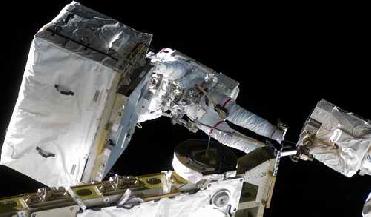
An artist's impression of interplanetary Internet. Photo credit -- NASA/JPL
WASHINGTON, DC (BNS): A deep-sea space communication network, on the lines of Internet, has been tested by NASA scientists using a software called Disruption Tolerant Networking (DTN).
The software was used to transmit images from a NASA science spacecraft. "This is a first step in creating a totally new space communications capability, an interplanetary Internet," said Adrian Hooke, manager of space-networking architecture, technology and standards at NASA headquarters in Washington.
The DTN software was used to transmit dozens of images to and from the spacecraft located some 20 million miles away from Earth, the space agency said. Work on the software started 10 years ago. NASA scientists and Vint Cerf, a vice-president at Google, began collaborating on a more secure way than the present day internet to transmit communication through deep space.
The officials said DTN should be free from disruptions, delays and disconnections in space. But there could be problems when spacecrafts move behind planets, or a solar storm can disrupt communication.
Interplanetary Internet is expected to be a big leap forward in space communication scenario. At present, NASA's information super highway to outer space is dependent on Deep Space Network.
Normal Internet uses Transmission Control Protocol/Internet Protocol (TCP/IP) for transmission of packets of data. The TCP/IP communications are designed to work over a continuous end-to-end connection between various parts of the network. So, it cannot be used for communication from Earth to Mars as there would be delays in sending a message. This delay could be as much as 20 minutes.
DTN, on the other hand, is designed to accommodate a store and forward system with built-in smarts. If one link in a communication chain is broken, a robot on Mars could decide for itself the next best way to get its data back to Earth.
"By making the best use of the contacts you've got, you can smooth out the load on the network, and avoid having the network just loitering on one spacecraft," said team leader Hooke.
NASA's engineers had begun a series of demonstrations for DTN in October, using Epoxi spacecraft as a Mars data-relay orbiter. Epoxi is primarily on a mission to encounter Comet Hartley 2 in two years. There were 10 nodes in the early interplanetary network – the Epoxi spacecraft itself and nine on the ground at the Jet Propulsion Laboratory simulating Mars landers, orbiters and ground mission-operations centers.
 Previous Article
Previous Article Next Article
Next Article













The Indian Air Force, in its flight trials evaluation report submitted before the Defence Ministry l..
view articleAn insight into the Medium Multi-Role Combat Aircraft competition...
view articleSky enthusiasts can now spot the International Space Station (ISS) commanded by Indian-American astr..
view article